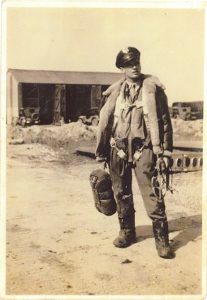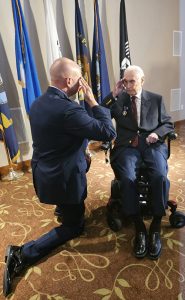Malcolm Champagne, a 102-year-old Glens Falls High School graduate, finally received a Purple Heart 80 years after his service in World War II.
It was presented at a senior living center in Portland, Oregon, on Sept. 15, POW-MIA Day, reported Stars and Stripes.

Born on Jan. 30, 1921 in Glens Falls, Lieutenant Champagne served as a navigator on a B-17 “Flying Fortress” bomber.
“Champagne was an ‘old-timer’ by the fall of 1943, with 15 missions flown,” the story said.
On Oct. 14, 1943 came the fateful “Black Thursday” raid on the ball-bearing plants at Schweinfurt, Germany, that Stars and Stripes said was one of the costliest American missions of World War II.
“The 8th Army Air Force had already hit Schweinfurt once — ball bearings were a crucial component in reducing metal friction in tanks, planes, and war machinery,” the article said.
On the ‘Black Thursday’ mission, “Champagne’s B-17 Flying Fortress bomber was ripped apart from the fighters and artillery flak, destroying the high-altitude oxygen system that was their only way to breathe at 20,000 feet.

Mr. Champagne is quoted, “We lost 60 B-17s that day — that’s 600 men.
“Of those 600 men, 300 survived. I’m one of those 300.”
The Stars and Stripes article, written by Gary Warner, said, “Champagne spent more than two years in Luft Stalag III, south of Berlin. The camp’s population had swelled to 7,500 Americans, 2,500 British, and 1,000 from other Allied forces by April 1945. In the closing days of the war, it was liberated by Soviet troops.”
The article said of the ‘Black Thursday’ raid, “Allied commanders hailed the mission as a success — 1,122 bombs dropped, 141 had landed in the factory area and 88 were direct hits — impressive numbers in an era of free-falling iron bombs.
“But the cost was high…Of the estimated 3,000 pilots and crew that left for Schweinfurt, 600 were killed, wounded or missing in action. It was later learned about 300 had been taken prisoner by the Germans. The 20% casualty rate was double what U.S. planners had considered an ‘acceptable loss.’
“Schweinfurt would be the last time U.S. bombers would venture so far into Germany until the new long-range P-51 Mustang escort fighters arrived in large numbers the next year.”
Prior to the Mustangs, the article explained, “Escort fighters of the time had a limited range of about 220 miles, allowing them to reach western Germany from England. After that, the bombers would fly on alone. British aircraft flew at night in ‘area bombing’ missions. The Americans preferred ‘precision daylight bombing’ to hit key targets.”
The story said that medals Lt. Champagne earned during his service were lost in a tidal wave of paperwork for the troops returning from war, but that his son, Ned Champagne, sought the approval for a Purple Heart for his father.
Eventually his case was reviewed and the Army approved the Purple Heart.
Mr. Champagne was also awarded the POW Medal, African-Middle Eastern Campaign Medal with one Bronze Service Star, World War II Victory Medal, and U.S. Army Air Force Navigator Wings at the ceremony, Stars and Stripes said.
This story was adapted by Ben Westcott & Mark Frost from Stars and Stripes, “the U.S. military’s independent news source.”
Copyright © 2023 Lone Oak Publishing Co., Inc. All Rights Reserved
 Glens Falls Chronicle Serving the Glens Falls/Lake George region; Warren, Washington and northern Saratoga counties since 1980
Glens Falls Chronicle Serving the Glens Falls/Lake George region; Warren, Washington and northern Saratoga counties since 1980


